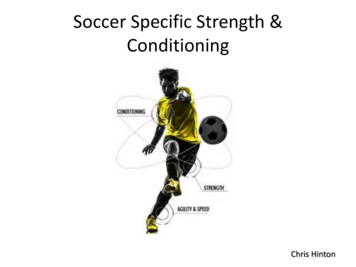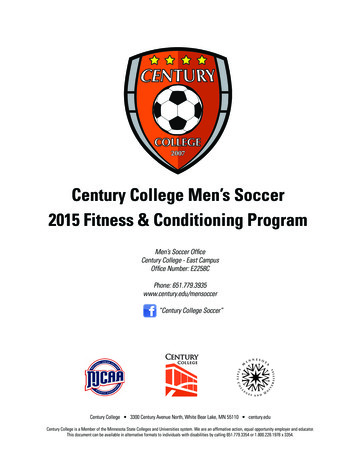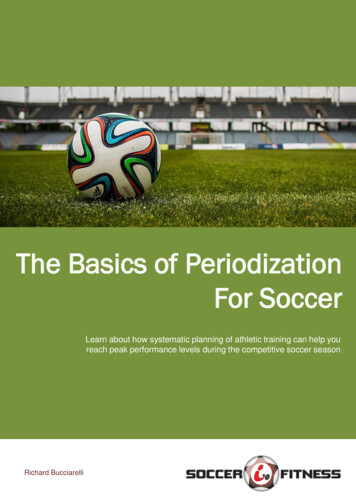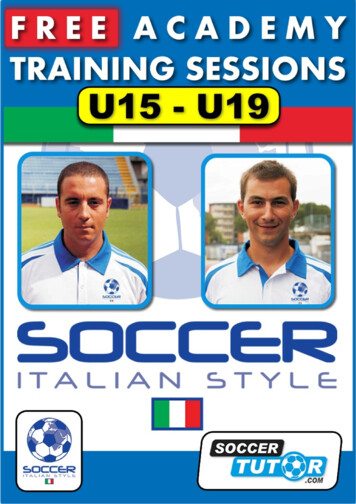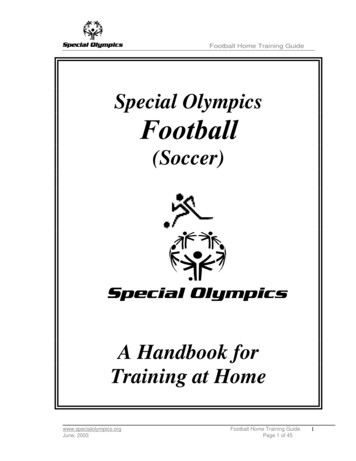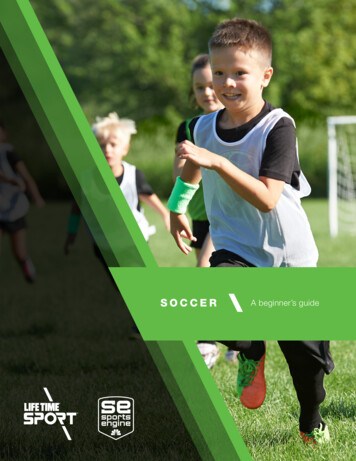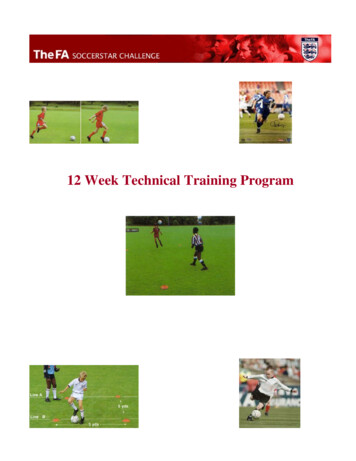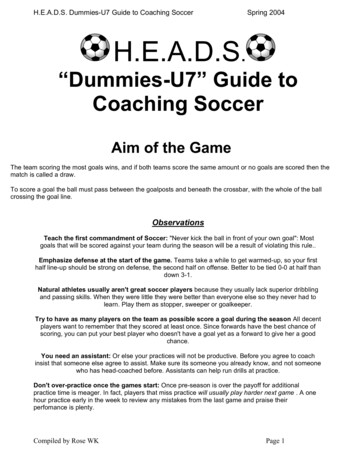
Transcription
H.E.A.D.S. Dummies-U7 Guide to Coaching SoccerSpring 2004H.E.A.D.S.“Dummies-U7” Guide toCoaching SoccerAim of the GameThe team scoring the most goals wins, and if both teams score the same amount or no goals are scored then thematch is called a draw.To score a goal the ball must pass between the goalposts and beneath the crossbar, with the whole of the ballcrossing the goal line.ObservationsTeach the first commandment of Soccer: "Never kick the ball in front of your own goal": Mostgoals that will be scored against your team during the season will be a result of violating this rule.Emphasize defense at the start of the game. Teams take a while to get warmed-up, so your firsthalf line-up should be strong on defense, the second half on offense. Better to be tied 0-0 at half thandown 3-1.Natural athletes usually aren't great soccer players because they usually lack superior dribblingand passing skills. When they were little they were better than everyone else so they never had tolearn. Play them as stopper, sweeper or goalkeeper.Try to have as many players on the team as possible score a goal during the season All decentplayers want to remember that they scored at least once. Since forwards have the best chance ofscoring, you can put your best player who doesn't have a goal yet as a forward to give her a goodchance.You need an assistant: Or else your practices will not be productive. Before you agree to coachinsist that someone else agree to assist. Make sure its someone you already know, and not someonewho has head-coached before. Assistants can help run drills at practice.Don't over-practice once the games start: Once pre-season is over the payoff for additionalpractice time is meager. In fact, players that miss practice will usually play harder next game . A onehour practice early in the week to review any mistakes from the last game and praise theirperfomance is plenty.Compiled by Rose WKPage 1
H.E.A.D.S. Dummies-U7 Guide to Coaching SoccerSpring 2004Some Soccer Concepts:In soccer where the ball starts depends on why play was last stopped:Kick-off: If a period is starting (unless the last period ended with a penalty) and after each goal the ballis kicked off from the center mark at midfield.Goal Kick: If a player puts the ball over the other team's end of the field without scoring, the refereewill set the ball down and let the other team have a "goal kick*".Corner Kick: If a player causes the ball to go over their own team's end of the field (unless a goal wasmade - you can score on yourself) the referee will put the ball down in a nearby corner of the field andgive the other team a "corner kick".Throw-in: If a player causes the ball to go past one of the sidelines, the other team may pick-up theball off the field with their hands and throw it back in.The goalkeeper is allowed to use her hands on the field when she's in the penalty box - a rectangledrawn in front of the goal. Otherwise players can't touch the ball with their shoulders, arms or hands(except to protect themselves from injury).Penalty kick: Causing a serious foul near your goal gives the other team a free kick with the ballplaced in front of your goal and no one to defend but the goalkeeper.Free kick: Causing a foul elsewhere on the field gives the other team a free kick from where the fouloccured. Less serious fouls only give an "indirect" kick where the ball has to be touched by anotherplayer before a goal can be scored1-2 - Essentially, a give-and-go50/50 ball - A loose ball contested by players from each team.advantage - When an official allows play to continue for the attacking team even though a fouloccurred.air-mail - A shot or chip sent way over the intended target.ambitious ball - An overly aggressive pass which had little chance of success.and-again - See wall pass, 1-2.assist - The pass which leads to a goal.away - Tells a defender to get the ball out their end of the field.back - Pass ball straight behind you.back and face - Following an attack, when midfield players are in advanced positions, this is aninstruction to return to their positions and face the opponents ready for the counter attack.back door - The furthest goalpost from the ball.back of square - Player is just behind a square ball to allow space in case of a bad pass.balance - Used to describe the concurrent presence of coverage by a team in important areas onthe pitch.banana Kick - A kick that makes the ball bend or swerve in the air instead of going straight.bending ball - See banana kick.bicycle kick - A spectacular backwards kick that ends with the player on his back and the ballgoing the other direction.booking - When a player commits a foul and either receives a yellow or red card.boots - Term used for soccer cleats.bunny-ball - Playing a ball to another player in a terrible position in order to make that player lookbad.Compiled by Rose WKPage 2
H.E.A.D.S. Dummies-U7 Guide to Coaching SoccerSpring 2004caught square - When two or more defenders have been beaten by a through ball because theywere positioned in a straight line or square to one another.center - A lateral pass to the inside, similar to a "square pass.challenge - To "challenge" the player with the ball.charge the ball - Not waiting for the ball to come to you, but instead running up on the ball andtaking it from your opponent.check - To come back to receive a ball from a teammate.check to - An offensive player running towards the ball carrier and usually calling for a pass.chip - A pass made by a stabbing motion of the kicking foot to the lower half of the ball to loft it overthe heads of opponents.chop - A deliberate change of direction with the ball usually using the inside of the foot.clear or clearance - Usually used in the defensive 1/3 of field. To play the ball out of the areataking away the opponents chances of offense.close down - When a defender gets close to the attacker without letting the attacker get by himwith the ball.contain - Do not allow a person with ball to beat you on the dribble.cover - To provide defensive cover to the defender pressuring the ball.cross - Pass or kick the ball across the mouth of the opponent's goal.dispossess - To take the ball away from a dribbler.dive - To fall down deliberately with the intention of fooling the referee into giving a foul.don't dive - Telling a defender to stay on his feet against a dribbler.drive - Hitting a low, hard shot on goal with the instep.drop - To pass the ball back to a supporting player.drop and mark - The defending team needs to move to their goal, picking up and markingopponents.drop in - support on defenseearn your shirt - Put in the effort in practice to get to play in the game.eyebrows - A flick on header at the near post from a corner-Ron Atkinson classic.face up - Face the direction of the ball. Don't turn back on ball during any stoppage of play.far post - The goal post furthest from the ball.field goal - When ball is blasted over the net {looks good that's all}.finish - When a player shoots the ball into the goal using anything but an instep kick.first time - Shoot or pass the ball with the first touch.flick - Advance the ball past the defenders for a teammate.football - The proper name of the sport.get up on that - Means to get up for a challenge in the air, and don't let the ball hit the ground. Or,to challenge in the air for a cross, dive or a collision with the opponent as a goalkeeper.ghost - An extra position where you wonder around on your half of the field playing defense.give him an oscar - When players fake injury.give-and-go - To pass the ball to a teammate, run past the defender, and the teammate returns theball.goal-side - The defender positioned between the goal and the offensive player.golden goal - A goal scored in overtime which ends the match.good out - A well cleared ball by a defender.good up - A good attempt at an executed head ball.hack - Someone who fouls way too much or an act of delivering a hard foul.half volley - Hitting the ball with the instep just after the ball has bounced off the ground.hard tackle - A fair, but rough tackle.hat trick - Three goals in a game by a player.have one - Tells a player to go ahead and take a shot at goal.heal - Backwards pass with the heal of your foot.hold - Usually means hold the ball while a player moves into a supporting position for a pass.hospital pass - A pass which might result in injury to a teammate striving to reach it first.Compiled by Rose WKPage 3
H.E.A.D.S. Dummies-U7 Guide to Coaching SoccerSpring 2004in swinger - Kicker will deliver corner kick swinging towards the goal.jockey - slow down the attacking player who has the ball with your back to your own goal trying tomake attacker go wide being close enough to him that if he shoots you will block it. No attempt to playthe ball is made while JOCKEYING.karaoke - Moving sideways in a fast motion and crossing legs.keeper - Stay away from the ball, the goalkeeper is coming out!killer pass - A pass that splits two defenders and puts your teammate in a great position.late tackle - A tackle after the ball was played by the offensive player. Should result in a foul.leave It - Don't touch the ball, let it roll by you.let him know you - Make contact with the striker early in match in attempt to put him off his game.line - Requesting a pass up touch line.man on - An opponent is approaching the player with the ball from behind.man to man marking - Follow him everywhere.mark up - Telling your teammates to leave no one unmarked.marking back - A fullback whose primary responsibility is to mark one of the opposing forwards.meg - When the ball is dribbled or passed between the legs of a defender.my bad - Said from one teammate to another to apologize for a poorly played ball.near post - The goal post nearest the ball.nothing - Either to tell your defender's that there will be no getting through them, or to clear the ballaway out of the back field!nutmeg - To put the ball between an opponent's legs.off the line - Referring to the goalkeeper moving from the goal line to get the ball.on the carpet - Pass on the ground.one more - Let a crossing pass through or pass to the next guy.one two - See all pass.one-timer - A goal scored on a cross or corner kick that is booted into the goal before it touches theground.open up - Use wingers and play wide.out swinger - Kicker will deliver corner kick with a ball swinging away from the goal.overlap - When a player runs around and ahead of the ball for a pass into space.pace - Referring to the speed of the ball from a pass.parry - A controlled and deliberate deflection by the goalkeeper using the hands.pitch - Another term for soccer field.play around them - To switch the ball from one side of the field to another with a sucession ofpasses.play feet. - To pass a ball directly to a teammate's feet.play on - Yelled and signaled by the referee when he sees a foul but allows the play to continuebecause an advantage for the attacking team.play space - To push a ball into an open area of the field for another player to run on to, asopposed to playing to feet.play the way your facing - Keep football simple and pass the way you are facing then move tospace.playing kickball - When a team uses the system of just kicking the ball as far as they can with noregard to passing.poser - A player who looks good but has no game.pressure - Refers to a defender placing pressure on his opponent with the ball.professional foul - A deliberate foul calculated to obtain an advantage such as intimidation of theopposition, or prevention of a subsequent goal scoring opportunity.pulling the string - A shot off a free kick that looks as if it will go over the crossbar but at the lastsecond dips into the goal.push-up - A sweeper telling his/her fellow defenders to stop lagging in the back, in an attempt todraw the opposing team off sides, or to get the defenders to get in on the offensive transition.rainbow - When a player pops the ball up and flicks the ball over their head in a forward motionCompiled by Rose WKPage 4
H.E.A.D.S. Dummies-U7 Guide to Coaching SoccerSpring 2004with the back of their heel.recover - When a defender gets beat he turns and sprints to get between the ball and the goal.recovery - Referring to a beaten defender running to get back into a defensive position.roll Infield - Switch positions with another player in the middle of the game.shape - The players positioning on the field in relation to the formation and the ball location.shell - A drop back past to the mid player with a shot and goal.show - Move from a position with an intervening defender to a position with a clear line to the ball.skip - Let it run to another player.smoked - When an offensive player performs a great move and leaves the defender in the dust.snap Him - Get stuck in and tackle him hard.sniper - Yelled when someone takes a dive with little or no contact.soft touch - A player has this when he can trap any pass that comes to him at any speed or height.sold him like a kipper - Sent him the wrong way with a turn.split - To pass the ball between two defenders.spot kick - A penalty kick.spun like a top - A defender who gets turned by a skilled dribbler.step or step It. - Instruction for defensive line to pull out for offside trap.stopper - The defender assigned to mark the other team's best forward.support - I am here in case you want to pass me the ball, or if you try to take on an opponent andloose possession I will be here to challenge immediately for the ball.sweeper - The player positioned behind the fullbacks and in front of the goalie who has theauthority to play either the right, middle or left side of the field (hence sweeps)to block the opposingteam's shot or player.switch - Means to switch the point of attack (i.e. switch the ball from the right side of the field to theleft).switch off - Trade marking assignments on defense.tackle - Trying to take the ball from opposing player. Always play the ball first, if contact is madewith the player first a foul is usually committed.take ball - Put pressure on the dribbler now!through ball - To serve the ball through a flat defensive alignment into a forward space creating anopportunity on goal.time - Having enough time to control ball and look around before a defender can pressure you.trail - I'm behind you if you need to pass it back.turn - Telling your teammate he has time to control the ball and turn up field.turn and face - Turn around and get ready for the kick.two-touch - To either shoot or pass a ball with the second touch, the touch after controlling the ball.unlucky - A nice short way of saying, "That wasn't your fault, just bad luck."upper v - The intersection of the crossbar and goalpost.wall - A human barrier between the ball and the goal on a free kick.wall pass - To pass the ball to a teammate, run past the defender, and have the teammate returnthe ball.weak side - The side of the field without the ball.well done - Great execution of a skill.well marshalled - Tightly marked. To defend and stay with a very good player with one or twodesignated players.what a cracker - A hard shot.what you see - The player with the ball has no one marking them, in other words, they areunmarked.wheel man - Central midfielder with primary responsibility for distributing the ball when team is onthe attack.winger - A wide attacker.Compiled by Rose WKPage 5
H.E.A.D.S. Dummies-U7 Guide to Coaching SoccerSpring 2004How to manage parentsParents are, obviously, necessary. Sometimes they can even be useful! You can, for example, getthem to transport children, fetch balls during practice sessions and provide financial support.There will, however, be occasions when you have difficulty with one or more parents. Some maywant their child to play more while others may question your judgment as a coach. You can minimizethe number of times you have to deal with an angry or upset parent by following these guidelines:1. Have a parent meeting before the first practice to discuss your plans and expectations for theseason. Encourage questions from the parents and let them know that you have given a lot ofthought to how you're going to coach their children.2. Express appreciation for their interest and concern. This will make them more open and at easewith you.3. Always listen to their ideas and feelings. Remember, they are interested and concerned becauseit is their children that are involved. Encourage parental involvement.4. Know what your objectives are and do what you believe to be of value to the team, not to theparents. No coach can please everyone!5. Know the club and game rules. Be prepared to abide by them and to explain them to parents.6. Handle any confrontation one-on-one and not in a crowd situation. Try not to be defensive. Letthe parent talk while you listen. Often a parent will vent their frustrations just by talking. Listen to theirviewpoint, then thank them for it.7. Resist unfair pressure. It is your responsibility as coach to make the final decision. This doesn’tmean that you can’t still listen to parents.8. Don’t discuss individual players with other parents. The grapevine will hang you every time.Show the same respect for each player on the team that you want the parents to show toward you.9. Ask parents not to criticize their children in front of anyone else. Don’t let your players behumiliated, even by their own parents.10. Don’t blame the players for their parents’ actions.Compiled by Rose WKPage 6
H.E.A.D.S. Dummies-U7 Guide to Coaching SoccerSpring 200411. Be consistent! If you change a rule or philosophy during the season, you may be in for trouble. Atthe very least, inform players and parents of any change as soon as possible.12. Most importantly, be fair! If you treat all your players fairly and equally you will gain their respectand that of their parents as well.Remember that your children (and their parents) are not all the same. They will have a wide variety ofbackgrounds, beliefs and ideals. This diversity is to be valued.The challenge for you as a coach is to address these differences in a positive manner so that theseason will be enjoyable for everyone involved.A typical U-6 training sessionWarm-upA very brief warm-up is appropriate in order to get the players thinking about soccer and toprepare them physically and mentally for the practice session. This should involve individualbody activities that may or may not involve the ball. They can chase a ball thrown by thecoach and bring it back with different parts of their body. Or they can chase someone withtheir ball at their feet. When they've been running around for a few minutes you can do somestatic stretching but try doing it with the ball.Individual activitiesFollow the warm-up with some kind of individual activity, not a real 1 v.1 game, but some kindof activity where players act as individuals in a game environment. An example would be akind of tag game, or "Red Light - Green Light", or a game where players are trying to knocktheir ball through gates. Keep players in motion at all times. Avoid having them wait in lines.Play games of "inclusion" instead of games of elimination.Play the gameMove on to the real game, but, make sure it is a 2 v 2, 3 v 3, or 4 v 4 so that everyone getsplenty of touches. You can have more than one game going on at a time if necessary. Switchthe game every 5 minutes or so. Be creative. Play with 4 goals or 2 balls. Play with or withoutboundaries. Use cones if you don't have real goals. Keep all the players involved.Compiled by Rose WKPage 7
H.E.A.D.S. Dummies-U7 Guide to Coaching SoccerSpring 2004Warm-downFinish the session with a warm down. Give them some more stretches to do with the ball.You may want to review what you started the session with.It is important to finish on time!How to teach soccer to pre-school childrenMy thanks to the Clovis Soccer Club for the information in this section.What to expect from U-6sCoaching pre-school, (i.e., under six), children is a lot of fun! Their enthusiasm knows no bounds, they will turnup for practice in the most severe weather conditions imaginable and they smile all the time!!Developmentally, however, they are very different from children who are just two or three years older.For example: Most of your players will cry immediately when they get hurt. Some cry even when they are not hurt, No matter how loud you shout, or how much they "practice" it, they can not or will not pass the ball, Somebody will come off the field in need of a toilet. Somebody will stay on the field when they shouldbe going to the toilet! The only player to hold a position is the goalkeeper (if you play with one.) Don't even considerteaching positional play, Twenty seconds after the start of a game, every player will be within 5 yards of the ball. Several players will slap at the ball with their hands, or pick it up. Several parents will yell atthem not to do that. A model rocket that is launched from a nearby field will get 99% of the player's attention. Byall means, stop whatever you are doing and watch for a couple of minutes. During a season, you will end up tying at least 40 to 50 shoelaces They will do something that is very funny. Make sure that you laugh.Compiled by Rose WKPage 8
H.E.A.D.S. Dummies-U7 Guide to Coaching SoccerSpring 2004What I say to the children every weekYou won't be coaching children for very long before you seem to hear an echo on the practicefield. But it's not an echo – it's you, repeating yourself over and over again!You will soon realise that it takes a long time and many, many repetitions before mostchildren, (especially children under the age of nine), really understand new concepts. Youhave to be very patient – your kids are not deliberately ignoring you when – for the hundredthtime – you tell them to “Get wide!” or “Play the way you're facing!”It's just that young children are very single minded in their approach to games. For example,in soccer they are attracted to the ball so strongly - like iron filings to a electromagnet! - that itis very hard for them to detach themselves from this cat like impulse enough to understandthat they can help their team by running AWAY from the ball sometimes.So you have to be patient.Don't worry, the penny will drop one day!!If you were to stand on the touchline at one of my practice sessions, these are the threeinstructions you'd hear most often:“Open up!”This term refers to the way players must prepare to receive the ball by opening up theirhips away from where the ball is coming from and in the direction they want to go next. Inpractice, this means that your children must receive the ball with the foot farthest awayfrom where it was just passed.Look at the way some coaches get their children to warm up. They get them to kick the ballback and forth to each other while standing still. There is a lot wrong with this activity,(how often do you stand still and pass/receive the ball in a match?!), but the primaryproblem is that it encourages children to face only the passer and ignore the rest of thefield. This is a habit that is hard to break. Make sure your passing exercises DO NOTinclude passing back and forth to a stationary target.Even if the receiver plans to pass it back to the area from where the ball is coming, openingup the hips will cause the defence to hesitate. They don’t know which direction the ball isgoing to be passed. If the hips are closed there is only one direction the ball can be played.Defenders will spot this and either compress the space or intercept the pass.You must incorporate into your training some exercises that develop this crucial skill. It isnot an exaggeration to say that the more ingrained this skill is, the more successful yourplayers will be.“Get wide!”Watch any group of six to nine year olds playing soccer and I guarantee that most of themwill be crowding around the ball like bees round a honey pot. It doesn't matter how goodthe coach is – most children of that age group simply cannot understand why they have to'get wide'.Compiled by Rose WKPage 9
H.E.A.D.S. Dummies-U7 Guide to Coaching SoccerSpring 2004You can help your kids appreciate the benefits of making space for themselves by notletting them play large sided games on a standard pitch. Limit the games you play at theend of your practice sessions to 3 v 3 or 4 v 4 and play on a wide than normal pitch. Evenbetter, don't use standard goals but set up with four small goals in each corner and nogoalies. This will, eventually, help your children to understand the benefits of getting theirheads up and looking across to the other side where – hopefully – one of their team mateswill be waiting to slot the ball into an empty 'net'.“Playthe way you face”This instruction simply means that your players should pass the ball in the direction theyare currently facing, even if it is back towards their own goal.You need to demonstrate that passing the ball to a player who is facing the goal you areattacking, even if he is farther away than you, is almost always the right thing to do.This has direct implications for defenders who are running on to a ball as they face theirown goal. Instead of trying to turn against the pressuring forward, they should either kickthe ball out of play (the safest option by far!) or pass the ball back to the goalkeeper.This one can also be called “don’t turn into pressure.” This is for the players who mustALWAYS try to go forward with the ball even when they have pressure all over them. Youcan be successful beating a defender occasionally, but if you try to turn into the pressureevery time the defender just waits until you make your move and then she takes it fromyou. Midfielders and forwards do this a lot in the younger age groups.The concept of unpredictability comes into play here as well. If you always make the samemove, then you will become very predictable for the other team to defend. If a defenderdoesn’t know whether you will pass or dribble, then she is less certain and hesitates. Thisuncertainty is usually enough to allow you to win most of your 1 v 1 challenges.This also covers the concept of shielding the ball as well. The point of shielding the ball isto keep it away from the defender. If you turn into the defender, you are exposing the ballto her and your chances of successfully beating her are low.“Don’t dive in.”This is simple 1v 1defender stuff. Most children who are defending their goal against anattacker will automatically challenge for the ball no matter what the situation. Often theywill be beaten by the forward thus creating trouble for the rest of the team as once the 1stdefender is beaten, one team has one less defender and the other has one more attacker.With younger players, you need to teach them to close quickly on the attacker. You wantyour defender close enough to be able to reach out and touch the player with the ball.This limits the time that the player has to think about what she will be doing with the ball.This is the first step in good defending.We also need to teach them to approach the attacker at an angle. If she runs straight onto the attacker, then the attacker can still go in any direction to beat her. We want to cutoff at least half of the field from the attacker by approaching from the side. this reducesthe amount of ground that our team has to defend. The rest of the players can thenCompiled by Rose WKPage 10
H.E.A.D.S. Dummies-U7 Guide to Coaching SoccerSpring 2004defend a smaller part of the field with greater numbers, thus increasing our chances ofsuccess.“Make diagonal passes”Most children will kick the ball straight up the field as this seems to be the most direct wayto advance the ball. However, it is not normally the best way to advance from defence intoattack. Why? Because the defence can predict with accuracy where the ball will end up.This means that the defending team are more likely to intercept the ball and create acounter attack.Defenders love it when the ball is played straight up the middle!If the ball is played diagonally instead, not only does the ball move, but also the defenderhas to turn to see it. If several diagonal balls are played, then the defenders have to turneach time a pass is made. If they are not perfect, then gaps will open up in their defence.This creates opportunities for penetrating passes or 1 v 1 moves with good attackersagainst weaker defenders. Any time we can make the defence turn and face their owngoal, we are in a very good attacking position.**You should demonstrate to your children that they can also see more of the field whenmaking diagonal passes. This can only help you keep possession of the ball.An example lesson planBy now you should have got a good idea of what you're going to teach your children and howyou're going to teach them.What you have to do now is to write it down.The process of jotting down notes will help you to keep focused on your objective for thelesson as well as remember the sequence of activities you've decided on. It will also help youto understand how you're going to join them all up so that your children are not standingaround while you're moving cones around.I cannot emphasise enough how important it is to have a clear, written plan beforeyou step onto the practice field. If you don't you could easily turn into the sort ofcoach who gets her kids running endless laps while she thinks about what to donext.Having a written plan will give you confidence in the early days of your 'career' as a youthsoccer coach. In my experience, knowing what you're going to do also enables you to relaxand deal much more confidently with any small discipline problems.Nothing (by the way) encourages children to misbehave as much as a coach who is clearlyfumbling her or her way through the session!!Compiled by Rose WKPage 11
H.E.A.D.S. Dummies-U7 Guide to Coaching SoccerSpring 2004You don't need to write hundreds of words. In fact, a few simple 'memory jogge
H.E.A.D.S. Dummies-U7 Guide to Coaching Soccer Spring 2004 Compiled by Rose WK Page 1 H.E.A.D.S. “Dummies-U7” Guide to Coaching Soccer Aim of the Game The team scoring the most goals wins, and if both teams score the same amoun

